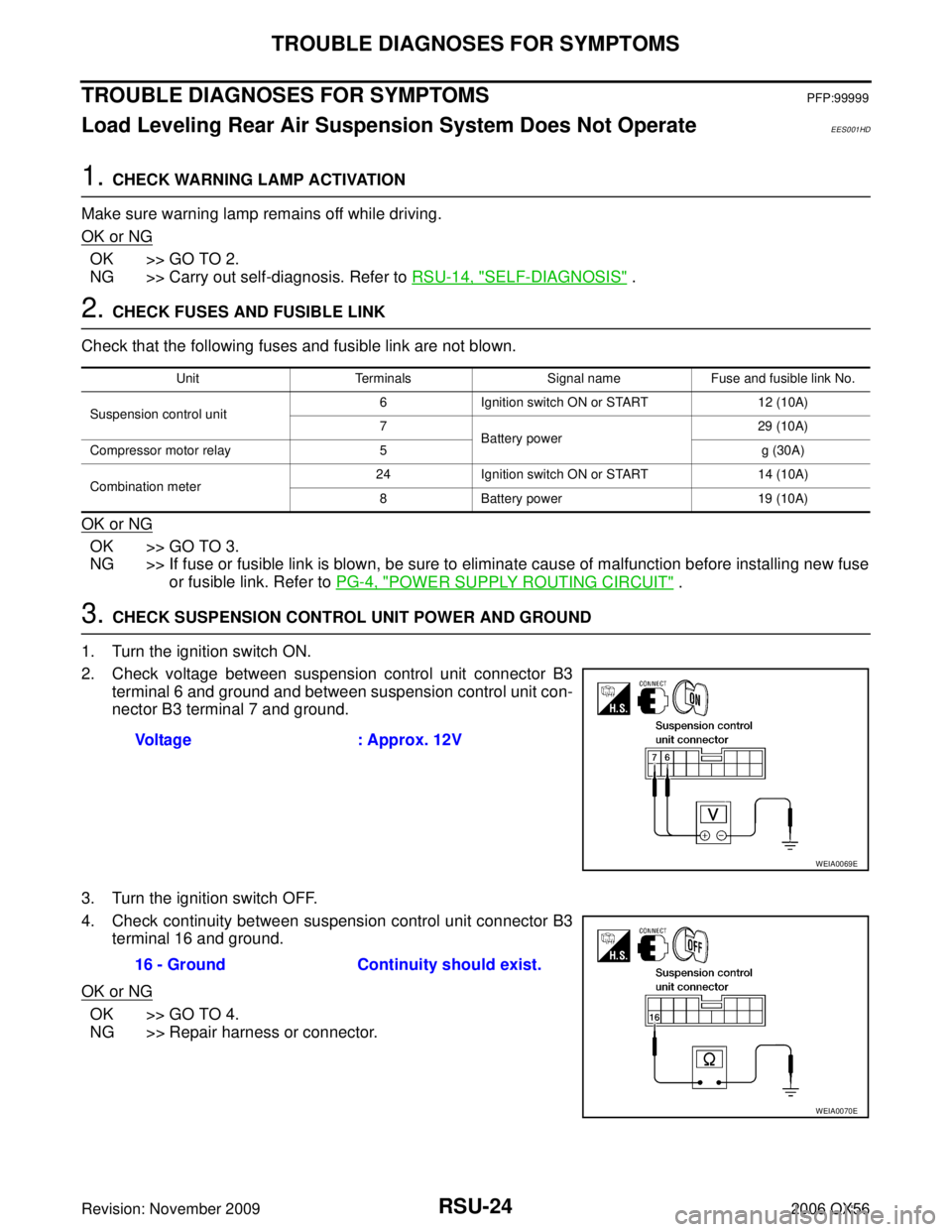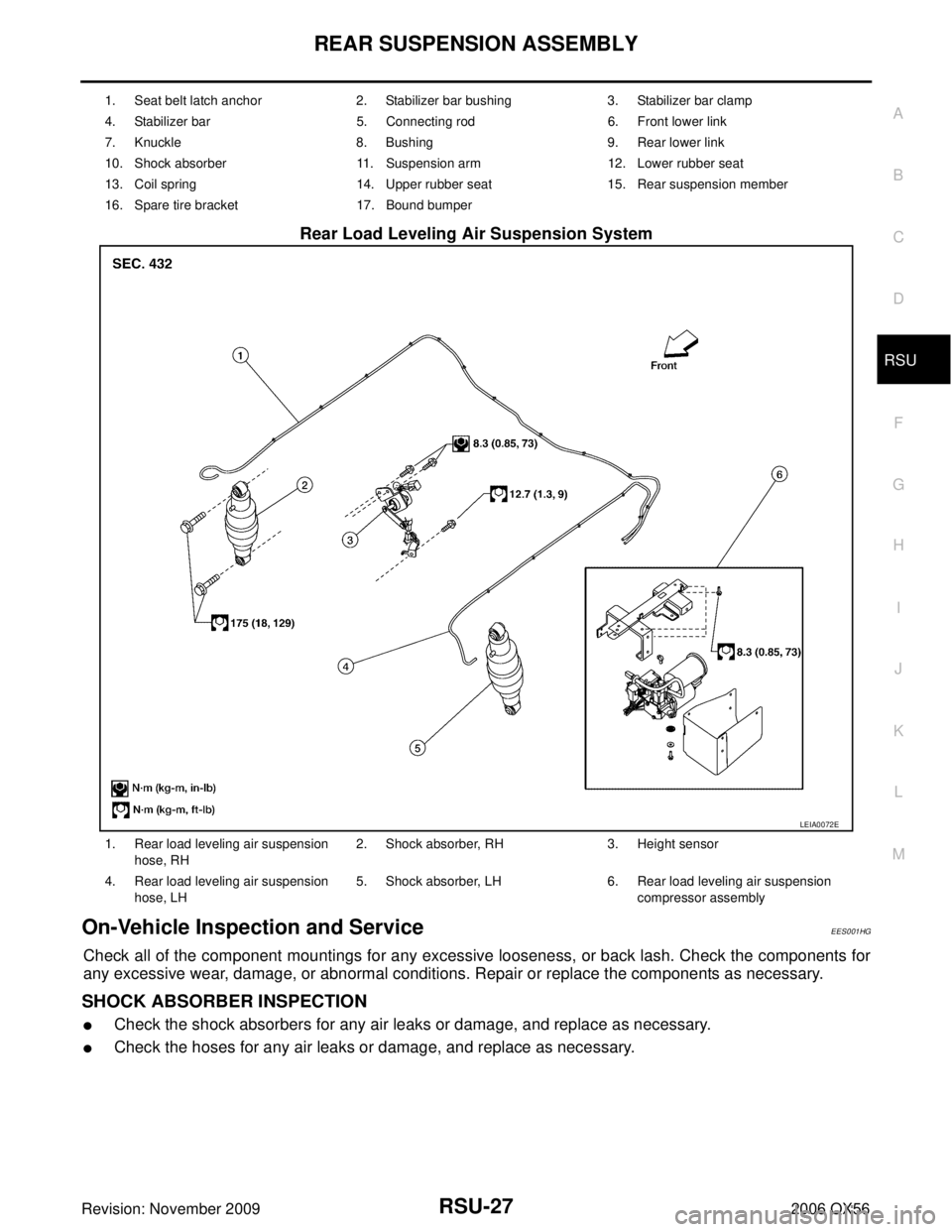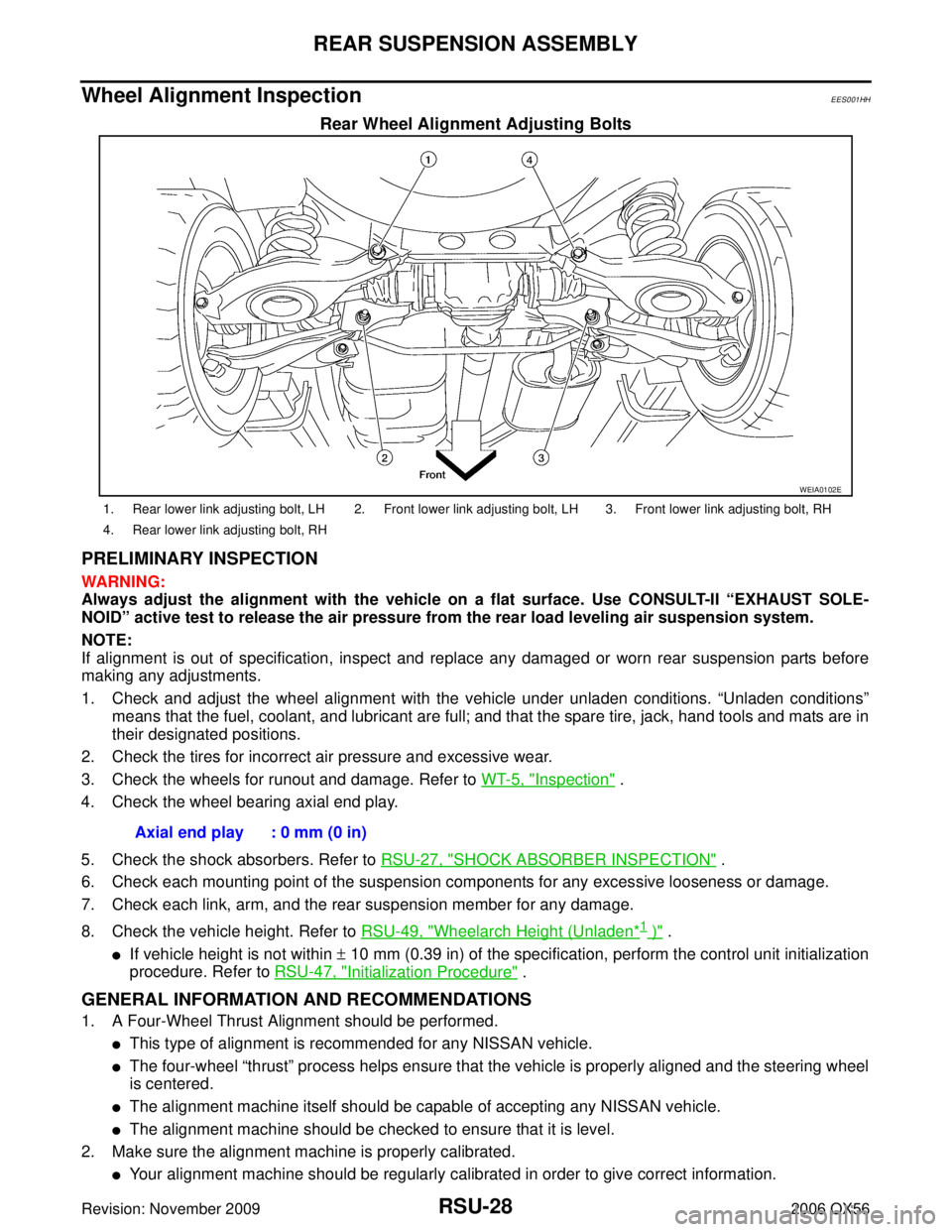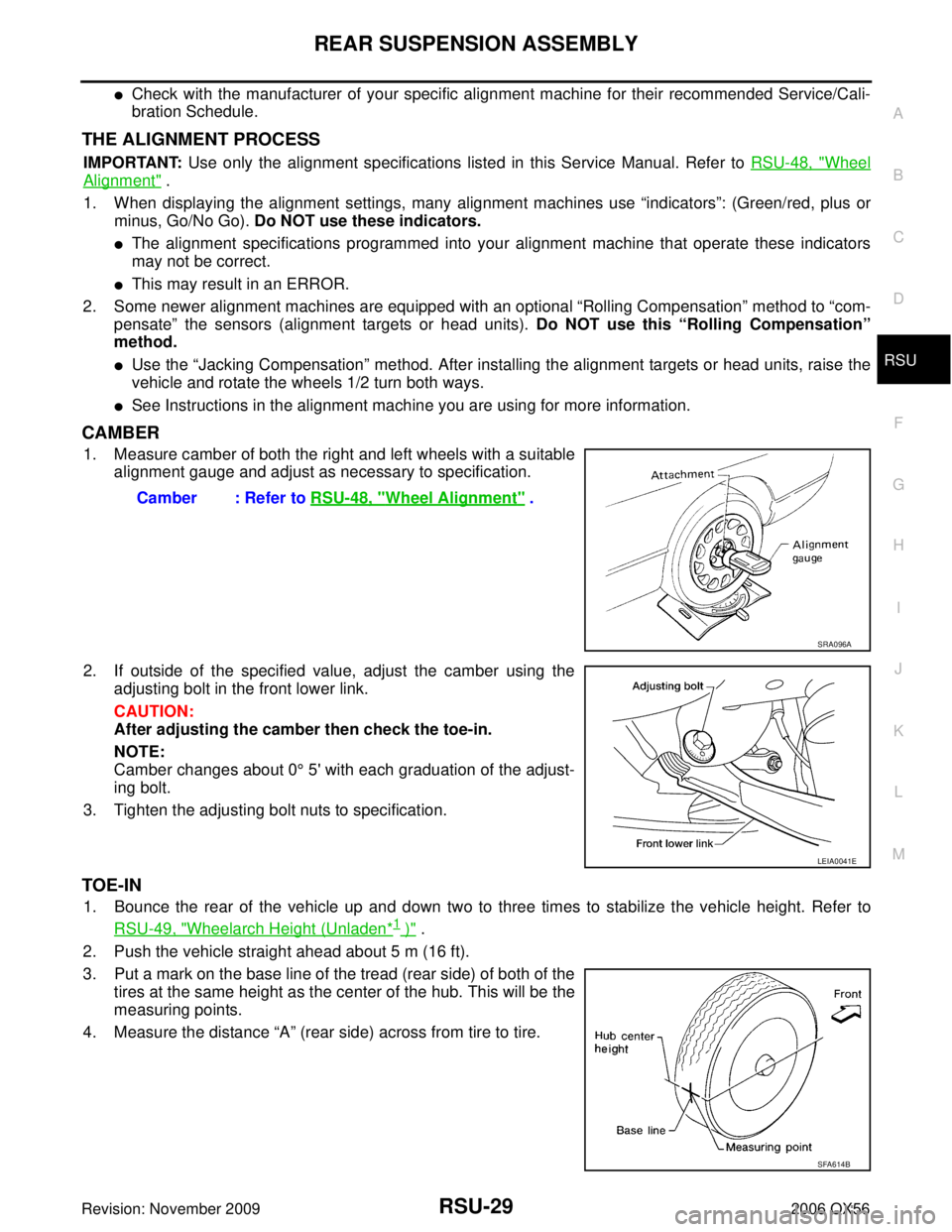Page 2861 of 3383

RSU-22
TROUBLE DIAGNOSIS FOR SELF-DIAGNOSTIC ITEMS
Revision: November 20092006 QX56
3. CONNECTOR INSPECTION
1. Disconnect suspension control unit connector B3 and suspension air compressor C9.
2. Check the terminals for deformation, disconnection, looseness or damage.
OK or NG
OK >> If code C1804 or C1808 was retrieved during self-diagnosis, GO TO 4. If code C1802 was retrieved during self-diagnosis, GO TO 6.
NG >> Repair or replace as necessary.
4. AIR HOSE INSPECTION
Inspect for pinched or damaged air hoses between the suspension air reservoir and each load leveling rear air
suspension shock absorber.
OK or NG
OK >> GO TO 5.
NG >> Repair or replace as necessary.
5. SUSPENSION AIR COMPRESSOR INSPECTION
Apply 12V to suspension air compressor terminal 2 and ground to
suspension air compressor terminal 1.
OK or NG
OK >> GO TO 6.
NG >> Replace the suspension air compressor. Refer to RSU-
43, "REAR LOAD LEVELING AIR SUSPENSION COM-
PRESSOR ASSEMBLY" .
System air pressure should vent.
WEIA0066E
Page 2862 of 3383
TROUBLE DIAGNOSIS FOR SELF-DIAGNOSTIC ITEMSRSU-23
C
DF
G H
I
J
K L
M A
B
RSU
Revision: November 2009 2006 QX56
6. CHECK SUSPENSION AIR COMPRESSOR POWER AND GROUND
1. Connect suspension control unit connector B3.
2. Turn the ignition switch ON.
3. Check voltage between suspension air compressor connector C9 terminal 2 and ground.
4. Turn ignition switch OFF.
5. Check continuity between suspension air compressor connector C9 terminal 1 and ground.
OK or NG
OK >> Replace the suspension control unit. Refer to RSU-47,
"CONTROL UNIT" .
NG >> Repair harness or connector. Voltage
: Approx. 12V
WEIA0090E
1 - GroundContinuity should exist.
WEIA0091E
Page 2863 of 3383

RSU-24
TROUBLE DIAGNOSES FOR SYMPTOMS
Revision: November 20092006 QX56
TROUBLE DIAGNOSES FOR SYMPTOMSPFP:99999
Load Leveling Rear Air Suspension System Does Not OperateEES001HD
1. CHECK WARNING LAMP ACTIVATION
Make sure warning lamp remains off while driving.
OK or NG
OK >> GO TO 2.
NG >> Carry out self-diagnosis. Refer to RSU-14, "
SELF-DIAGNOSIS" .
2. CHECK FUSES AND FUSIBLE LINK
Check that the following fuses and fusible link are not blown.
OK or NG
OK >> GO TO 3.
NG >> If fuse or fusible link is blown, be sure to eliminate cause of malfunction before installing new fuse or fusible link. Refer to PG-4, "
POWER SUPPLY ROUTING CIRCUIT" .
3. CHECK SUSPENSION CONTROL UNIT POWER AND GROUND
1. Turn the ignition switch ON.
2. Check voltage between suspension control unit connector B3 terminal 6 and ground and between suspension control unit con-
nector B3 terminal 7 and ground.
3. Turn the ignition switch OFF.
4. Check continuity between suspension control unit connector B3 terminal 16 and ground.
OK or NG
OK >> GO TO 4.
NG >> Repair harness or connector.
Unit Terminals Signal nameFuse and fusible link No.
Suspension control unit 6
Ignition switch ON or START 12 (10A)
7 Battery power 29 (10A)
Compressor motor relay 5 g (30A)
Combination meter 24
Ignition switch ON or START 14 (10A)
8 Battery power 19 (10A)
Voltage: Approx. 12V
WEIA0069E
16 - Ground Continuity should exist.
WEIA0070E
Page 2864 of 3383
TROUBLE DIAGNOSES FOR SYMPTOMSRSU-25
C
DF
G H
I
J
K L
M A
B
RSU
Revision: November 2009 2006 QX56
4. CHECK GENERATOR SIGNAL INPUT
1. Start the engine.
2. Check voltage between suspension control unit connector B3 terminal 15 and ground.
OK or NG
OK >> Replace the suspension control unit. Refer to RSU-47,
"CONTROL UNIT" .
NG >> Repair the circuit.
CK SUSP Indicator Lamp Stays On When Ignition Switch Is Turned OnEES001HE
1. CARRY OUT SELF-DIAGNOSIS
Carry out self-diagnosis. Refer to RSU-14, "
SELF-DIAGNOSIS" .
Are malfunctions detected in self-diagnosis?
YES >> Refer to RSU-16, "Display Item List" .
NO >> Refer to DI-31, "
WARNING LAMPS" .
Voltage : Approx. 12V
WEIA0071E
Page 2865 of 3383
RSU-26
REAR SUSPENSION ASSEMBLY
Revision: November 20092006 QX56
REAR SUSPENSION ASSEMBLYPFP:55020
ComponentsEES001HF
Rear Suspension
WEIA0092E
Page 2866 of 3383

REAR SUSPENSION ASSEMBLYRSU-27
C
DF
G H
I
J
K L
M A
B
RSU
Revision: November 2009 2006 QX56
Rear Load Leveling Air Suspension System
On-Vehicle Inspection and ServiceEES001HG
Check all of the component mountings for any excessive looseness, or back lash. Check the components for
any excessive wear, damage, or abnormal conditions. Repair or replace the components as necessary.
SHOCK ABSORBER INSPECTION
�Check the shock absorbers for any air leaks or damage, and replace as necessary.
�Check the hoses for any air leaks or damage, and replace as necessary.
1. Seat belt latch anchor2. Stabilizer bar bushing3. Stabilizer bar clamp
4. Stabilizer bar 5. Connecting rod6. Front lower link
7. Knuckle 8. Bushing9. Rear lower link
10. Shock absorber 11. Suspension arm12. Lower rubber seat
13. Coil spring 14. Upper rubber seat15. Rear suspension member
16. Spare tire bracket 17. Bound bumper
LEIA0072E
1. Rear load leveling air suspension
hose, RH 2. Shock absorber, RH 3. Height sensor
4. Rear load leveling air suspension hose, LH 5. Shock absorber, LH
6. Rear load leveling air suspension
compressor assembly
Page 2867 of 3383

RSU-28
REAR SUSPENSION ASSEMBLY
Revision: November 20092006 QX56
Wheel Alignment InspectionEES001HH
Rear Wheel Alignment Adjusting Bolts
PRELIMINARY INSPECTION
WARNING:
Always adjust the alignment with the vehicle on a flat surface. Use CONSULT-II “EXHAUST SOLE-
NOID” active test to release the air pressure from the rear load leveling air suspension system.
NOTE:
If alignment is out of specification, inspect and replace any damaged or worn rear suspension parts before
making any adjustments.
1. Check and adjust the wheel alignment with the vehicle under unladen conditions. “Unladen conditions”
means that the fuel, coolant, and lubricant are full; and that the spare tire, jack, hand tools and mats are in
their designated positions.
2. Check the tires for incorrect air pressure and excessive wear.
3. Check the wheels for runout and damage. Refer to WT-5, "
Inspection" .
4. Check the wheel bearing axial end play.
5. Check the shock absorbers. Refer to RSU-27, "
SHOCK ABSORBER INSPECTION" .
6. Check each mounting point of the suspension components for any excessive looseness or damage.
7. Check each link, arm, and the rear suspension member for any damage.
8. Check the vehicle height. Refer to RSU-49, "
Wheelarch Height (Unladen*1 )" .
�If vehicle height is not within ± 10 mm (0.39 in) of the specification, perform the control unit initialization
procedure. Refer to RSU-47, "
Initialization Procedure" .
GENERAL INFORMATION AND RECOMMENDATIONS
1. A Four-Wheel Thrust Alignment should be performed.
�This type of alignment is recommended for any NISSAN vehicle.
�The four-wheel “thrust” process helps ensure that the vehicle is properly aligned and the steering wheel
is centered.
�The alignment machine itself should be capable of accepting any NISSAN vehicle.
�The alignment machine should be checked to ensure that it is level.
2. Make sure the alignment machine is properly calibrated.
�Your alignment machine should be regularly calibrated in order to give correct information.
WEIA0102E
1. Rear lower link adjusting bolt, LH 2. Front lower link adjusting bolt, LH 3. Front lower link adjusting bolt, RH
4. Rear lower link adjusting bolt, RH
Axial end play : 0 mm (0 in)
Page 2868 of 3383

REAR SUSPENSION ASSEMBLYRSU-29
C
DF
G H
I
J
K L
M A
B
RSU
Revision: November 2009 2006 QX56
�Check with the manufacturer of your specific alignment machine for their recommended Service/Cali-
bration Schedule.
THE ALIGNMENT PROCESS
IMPORTANT: Use only the alignment specifications listed in this Service Manual. Refer to RSU-48, "Wheel
Alignment" .
1. When displaying the alignment settings, many alignment machines use “indicators”: (Green/red, plus or
minus, Go/No Go). Do NOT use these indicators.
�The alignment specifications programmed into your alignment machine that operate these indicators
may not be correct.
�This may result in an ERROR.
2. Some newer alignment machines are equipped with an optional “Rolling Compensation” method to “com-
pensate ” the sensors (alignment targets or head units). Do NOT use this “Rolling Compensation”
method.
�Use the “Jacking Compensation ” method. After installing the alignment targets or head units, raise the
vehicle and rotate the wheels 1/2 turn both ways.
�See Instructions in the alignment machine you are using for more information.
CAMBER
1. Measure camber of both the right and left wheels with a suitable alignment gauge and adjust as necessary to specification.
2. If outside of the specified value, adjust the camber using the adjusting bolt in the front lower link.
CAUTION:
After adjusting the camber then check the toe-in.
NOTE:
Camber changes about 0 ° 5' with each graduation of the adjust-
ing bolt.
3. Tighten the adjusting bolt nuts to specification.
TOE-IN
1. Bounce the rear of the vehicle up and down two to three times to stabilize the vehicle height. Refer to RSU-49, "
Wheelarch Height (Unladen*1 )" .
2. Push the vehicle straight ahead about 5 m (16 ft).
3. Put a mark on the base line of the tread (rear side) of both of the tires at the same height as the center of the hub. This will be the
measuring points.
4. Measure the distance “A” (rear side) across from tire to tire.
Camber : Refer to
RSU-48, "
Wheel Alignment" .
SRA096A
LEIA0041E
SFA614B